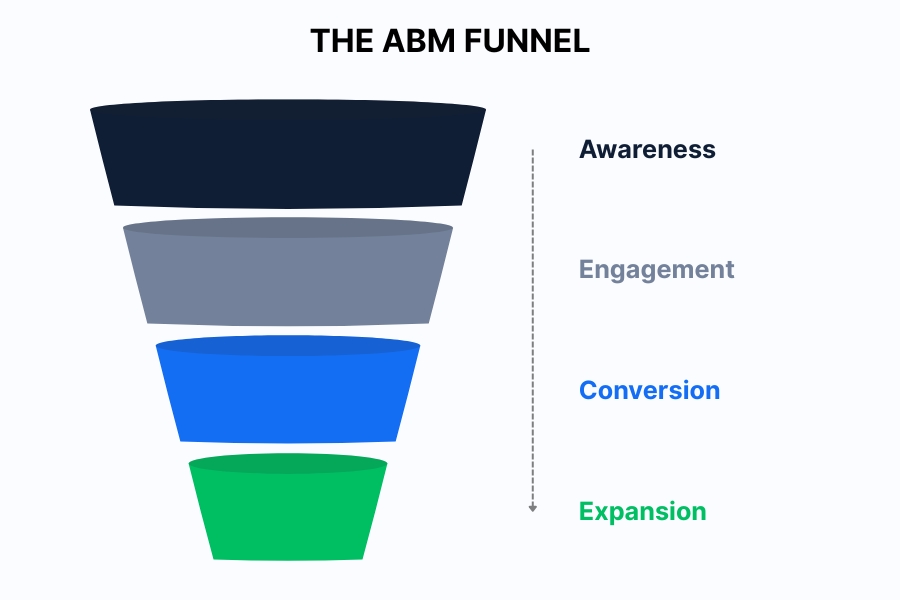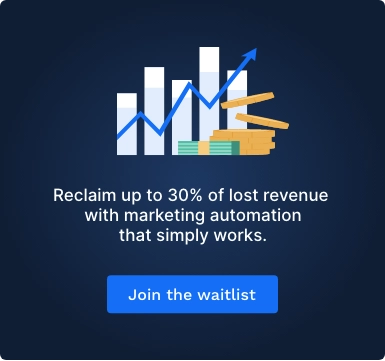Account-based marketing (ABM) has been a proven B2B growth strategy for years, if not decades. Instead of chasing thousands of leads, ABM focuses on the accounts that matter most — aligning sales and marketing to create personalized campaigns that drive revenue.
ABM is one of the most effective approaches for B2B teams looking to maximize ROI and close high-value deals.
In this guide, we’ll break down the fundamentals of account-based marketing strategy, show you how to identify and prioritize the right accounts, and share actionable steps to execute campaigns successfully.
Along the way, we’ll highlight the key metrics and show you how to utilize the right tools to make ABM scalable and predictable.

What is account-based marketing?
Account-based marketing (ABM) is a highly targeted B2B marketing strategy that focuses on engaging and converting specific, high-value accounts, instead of targeting a large pool of generic leads.
Rather than prioritizing volume, ABM prioritizes relevance: sales and marketing teams work together to identify key accounts, tailor outreach, and deliver personalized campaigns that speak directly to decision-makers.
Unlike traditional lead-based marketing, which measures success by the number of leads generated, ABM focuses on quality, nurturing fewer accounts but with higher precision and deeper engagement.
In the B2B space, ABM plays a crucial role in industries with long sales cycles, multiple stakeholders, and high contract values.
While it’s often associated with large enterprises, the reality is that ABM is equally powerful for SaaS startups, agencies, and mid-sized B2B companies looking to scale efficiently.

Common misconceptions about ABM
1. ABM is only for large companies and enterprises
Truth: ABM works for companies of all sizes. With the right tools (like eGrowthEngine), even small SaaS firms can run effective and scalable ABM campaigns.
2. ABM is just outbound marketing with extra steps
Truth: ABM is not about spamming accounts with emails or ads. It’s about identification, validation, precision, personalization, and alignment between marketing and sales.
3. ABM is expensive and slow to show ROI
Truth: If done manually, ABM takes time to yield results. However, powering your ABM campaigns with automation and data-driven insights can lead to faster and measurable results with favorable ROI.
Why ABM matters for B2B companies?

Account-based marketing has become a cornerstone for B2B organizations because it aligns resources with the accounts that matter most.
Instead of spreading efforts across thousands of potential leads, ABM ensures marketing and sales teams concentrate on the highest-value opportunities that are most likely to convert, renew, and expand.
Let’s look at the key benefits of ABM for B2B teams:
1. Higher ROI: ABM consistently outperforms traditional lead-based marketing because campaigns are designed for relevance and precision. (SOURCE)
2. Shorter sales cycles: Personalized engagement with decision-makers helps eliminate wasted steps and moves accounts faster through the funnel.
3. Improved win rates: Targeting accounts that already fit your ICP (Ideal Customer Profile) means more deals close successfully.
4. Stronger customer relationships: Since messaging and content are tailored, ABM fosters trust and creates opportunities for long-term partnerships.
5. Sales and marketing alignment: ABM requires collaboration between teams, reducing silos and creating a unified approach toward key accounts.
The ABM funnel
The ABM funnel differs slightly from the traditional marketing funnel in terms of how opportunities navigate the decision-making process. It comprises four stages – Awareness, Engagement, Conversion, and Expansion – as illustrated below.

Building the foundation: The ABM approach

An effective account-based marketing strategy starts with a strong foundation. At its core, ABM is about precision — defining the accounts most likely to deliver long-term value, aligning sales and marketing around them, and tailoring campaigns to fit their specific needs.
Unlike traditional marketing, which emphasizes generating as many leads as possible, ABM focuses on fewer but higher-quality accounts, ensuring every touchpoint is relevant and impactful.
Here are three foundational steps of an account-based marketing plan.
1. Building an Ideal Customer Profile (ICP)
An ICP helps define the type of accounts most likely to convert and remain loyal. It combines:
- Firmographics: Industry, size, region, and revenue
- Technographics: Technology stack and tools already in use
- Behavioral signals: Level of engagement with your brand, pain points, and goals
With a clear ICP, you have the framework needed to recognize accounts that fit your solution and are worth targeting.
2. Identifying high-value target accounts
Once your ICP is in place, you can begin filtering and selecting accounts that best match it. This involves looking at:
- Industry and vertical alignment
- Current business challenges
- Growth potential and expansion opportunities
- Compatibility with your product/service
- Recent engagement with your brand (content downloads, demo requests, event attendance)
Example:
Imagine your ICP is mid-market SaaS companies in North America with 50–200 employees, investing actively in digital marketing and sales enablement.
A company (let’s call it X-Company) that recently raised Series B funding and engaged with your case study on scaling customer acquisition would qualify as a high-value target. They align with your ICP, show signals of readiness, and represent strong expansion potential.
3. Aligning marketing and sales for ABM success
ABM fails when sales and marketing operate in silos. Success comes from alignment:
Shared account lists and prioritization criteria: Both teams should agree on target accounts based on the ICP to avoid wasted effort.
- Joint planning for campaigns and touchpoints: Marketing and sales must coordinate campaigns so outreach feels seamless, not fragmented.
- Consistent messaging and positioning: A unified value proposition ensures prospects hear the same story at every stage.
- Transparent reporting on account progress: Shared dashboards keep both teams accountable for engagement, pipeline, and revenue.
Key components of a successful account-based marketing strategy

A strong ABM strategy is more than just selecting accounts. It’s about building a framework that ensures personalized engagement, consistent execution, and measurable outcomes. Here are the essential components every ABM program needs:
1. Personalization at scale
ABM thrives on relevance. Instead of generic campaigns, each interaction is tailored to the account’s needs, challenges, and goals. With automation, companies can personalize across thousands of accounts without sacrificing personalized engagement.
2. Multi-channel orchestration
No single channel is enough to engage B2B accounts. ABM requires a coordinated presence across email, social, paid ads, events, and even offline touchpoints like direct mail. When all channels reinforce the same message, engagement becomes stronger and more consistent.
3. Content mapping to the ABM customer journey
Different stakeholders at different stages need different content. Thought leadership for awareness, case studies for evaluation, and ROI calculators for decision-making all play a role. Mapping content to funnel stages ensures every touchpoint feels timely and valuable.
4. Data and insights-driven targeting
Strong ABM runs on data. Firmographic, technographic, and behavioral insights help teams identify the right accounts and understand what messaging will resonate. Without actionable data, ABM risks being guesswork.
5. Technology and automation
Managing ABM manually is error-prone and time-consuming, making it inefficient. ABM platforms and marketing automation tools like eGrowthEngine make it possible to scale personalization, orchestrate campaigns, and measure results without overloading teams.
6. Measurement and optimization
ABM is iterative. By tracking engagement, conversion, and revenue impact at the account level, teams can refine targeting, improve personalization, and double down on what works. In the following sections, we’ll discuss ABM metrics in detail.
Metrics that matter: How to measure ABM success
ABM isn’t just about targeting fewer accounts — it’s about proving that your efforts with those accounts drive measurable business outcomes. Traditional lead-based metrics (like MQL volume) don’t tell the full story.
Instead, ABM requires account-focused metrics and KPIs that reflect engagement, pipeline progression, and revenue impact.
Here’s a list of account-based marketing KPIs that you should track.
1. Account engagement
This isn’t a single metric but a combination of metrics that indicate how target accounts interact with your campaigns, website, and content. Look at email open rates, ad impressions, webinar attendance, and page visits at the account level instead of individual leads.
2. Pipeline velocity
This metric measures the impact of ABM campaigns on the speed and efficiency of moving accounts through the sales funnel. It indicates whether targeted accounts progress from initial engagement to closed deals more quickly than non-targeted accounts.
How to calculate:
Pipeline Velocity = (Number of Opportunities × Average Deal Value × Win Rate) ÷ Length of Sales Cycle
3. Conversion rate
Also known as win rate or close rate, conversion rate refers to the percentage of targeted accounts that get converted into paying customers.
How to calculate:
Conversion Rate = (Number of deals won ÷ Number of targeted accounts) × 100
Note: Similarly, you can calculate conversion rates for:
Targeted accounts → Opportunities
Opportunities → Deals won
4. Average deal size
It measures the average revenue generated from each closed deal. This metric indicates if your ABM efforts are helping you win larger, more strategic contracts.
How to calculate:
Average Deal Size = Total Revenue from Deals ÷ Number of Deals
5. Account penetration
This metric measures the depth of engagement with a target account by tracking the percentage of stakeholders reached compared to the total number of stakeholders involved in the buying process.
How to calculate:
Account Penetration = (Engaged Stakeholders ÷ Total Buying Committee Members) × 100
6. Marketing qualified accounts (MQAs)
Marketing qualified accounts (like Marketing qualified leads or MQLs in general marketing) are the targeted accounts that meet ICP criteria and show clear intent.
How to calculate:
MQA Rate = (Number of MQAs ÷ Total Target Accounts) × 100
7. Customer lifetime value (LTV)
This metric tracks the long-term value of ABM-won customers. A higher average LTV indicates a higher retention and satisfaction rate among closed customers.
How to calculate:
Average CLV = (Total revenue generated across all deals ÷ Total number of deals closed)
8. Retention rate
It calculates the percentage of closed customers who have repurchased or renewed the services.
How to calculate:
Retention Rate = (Total renewals/repurchases ÷ Total customers) x 100
Note: Similarly, you can calculate upsell/cross-sell rates.
9. Retention revenue
This metric measures how much revenue comes from renewals among ABM accounts.
How to calculate:
Retention Revenue: (Renewal revenue ÷ Total revenue) x 100
Note: Similarly, you can calculate upsell/cross-sell revenue.
6-step plan to execute your account-based marketing strategy successfully

We’ve talked about the building blocks of ABM and how to measure its success. Now, let’s look at how to execute an ABM campaign in 6 practical steps.
1. Select and segment accounts effectively
Start with your ICP and create a list of accounts that match it closely. Use data points such as industry, company size, location, and technology stack.
Next, segment the list into smaller groups (e.g., enterprise healthcare, mid-market SaaS, financial services startups). This segmentation makes it easier to run campaigns that feel tailored without needing to create one-off assets for every account.
2. Orchestrate campaigns across multiple channels
Plan your campaigns so that target accounts see consistent messaging everywhere. Combine channels like personalized email outreach, LinkedIn ads, website personalization, direct mail, and executive events.
Map out a timeline of when and how each channel will be used, and assign responsibilities between marketing and sales. This ensures that accounts are “surrounded” by relevant touchpoints instead of receiving random, disconnected messages.
3. Personalize your outreach to account needs
Go deeper than generic messaging. Research each account’s current challenges, goals, and industry context. Then build messages that speak to those specifics.
For example, if an account recently expanded internationally, highlight how your solution supports global scalability. Create industry-specific landing pages, custom email copy, or even personalized video messages where possible.
The more relevant your outreach feels, the higher the response rates.
4. Align content with personas and buying stages
Audit your existing content library and map assets to both stakeholder roles and funnel stages. Executives may need ROI-focused case studies, while technical buyers may prefer integration guides or demos.
For each account segment, plan a content path that moves them from awareness (thought leadership, industry reports) to consideration (case studies, product comparisons) to decision (ROI calculators, proposals). This ensures every touchpoint drives the account closer to conversion.
5. Measure results and iterate continuously
Set up dashboards that track engagement at the account level — emails opened, ads clicked, meetings booked, and opportunities created.
Compare ABM accounts against non-ABM accounts to see differences in pipeline velocity, win rates, and deal size. Use this data to identify what’s working and refine campaigns.
For example, if ads generate high awareness but low conversions, adjust the creative or test new formats. Iteration needs to be a built-in part of your ABM workflow.
6. Activate sales with insights and playbooks
Lastly, share account-level insights with your sales team so they know how each account has engaged. Provide talking points, email templates, and recommended next steps based on account behavior.
For instance, if a key contact has downloaded a pricing guide, sales can follow up with a tailored conversation about ROI. Regular alignment meetings ensure sales and marketing work from the same playbook.
POV: A cybersecurity firm’s ABM campaign in action
Imagine you run a cybersecurity services firm targeting mid-market financial companies. Here’s how an ABM plan might look in practice:
- Define ICP: 200–2,000 employee firms in finance or healthcare with new CISOs or compliance deadlines.
- Build account list: Segment into Tier 1 (30 strategic accounts with deep personalization) and Tier 2 (broader accounts with lighter touches).
- Map buying committee: CIO, CISO, compliance head, and security operations lead.
- Tailor messaging: CISOs get compliance audit readiness content; CIOs see ROI and downtime reduction proof.
- Run campaign plays: Email + LinkedIn touches, offer a free risk snapshot, invite to a tabletop exercise, and follow with a pilot.
- Measure success: Track MQAs created, meetings booked, pipeline velocity, and average deal size.
Scale your ABM campaigns with eGrowthEngine
Even the best ABM strategy fails without the right tools to run it at scale. That’s where eGrowthEngine comes in.
- Audience management: Build and segment account lists based on your ICP, industry, or engagement signals.
- Personalized campaigns at scale: Run tailored email sequences that adjust automatically based on behavior.
- Automation flows: Trigger personalized outreach, follow-ups, and reminders without manual effort.
- Sales–marketing alignment: Share account-level insights across teams, ensuring every touchpoint feels consistent and relevant.
- Analytics that matter: Track pipeline velocity, account engagement, and deal progression in real time to double down on what works.
eGrowthEngine helps you put ABM on autopilot — making campaigns more precise, less resource-heavy, and easier to scale.

Wrap up: Account-based marketing strategy
ABM works because it’s built on focus and precision. By zeroing in on high-value accounts, aligning your teams, and delivering tailored experiences, you create stronger relationships and higher revenue opportunities than traditional lead-based marketing ever could.
The key is execution. You must build a repeatable process that combines account selection, personalization, and data-driven optimization. Add the right automation layer, and you can scale ABM without losing the human touch that makes it effective.
That’s exactly what eGrowthEngine enables: a marketing automation platform designed to help B2B companies capture, nurture, and convert target accounts into loyal customers.
If you’re ready to turn ABM from theory into practice, now is the time to put your strategy into action.
You may also like
Churn Rate Reduction Guide: How to Predict, Measure, and Reduce Customer Churn in B2B
Customer churn rate is one of the biggest risks to sustainable B2B growth. This churn reduction guide explains how to measure churn rate, predict churn risk, and build an actionable plan to improve customer retention.
SaaS Marketing Guide: How to Convert Free Users into Paying Customers
In this guide, we’ll show you how to build high-converting free experiences, track the right signals, and create a scalable SaaS marketing process for conversion. Whether you’re offering a free trial or a freemium plan, this article will help you...
Benefits of Email Marketing: 12 Reasons Why Email Marketing Still Reigns
Whether you're a startup or a growing brand, email gives you a direct, personal line of communication with your customers. Let's look at the most important benefits of email marketing and why it should be a key part of your email marketing strategy.
Cold Email Outreach Strategy: How to Approach, Nurture, and Close Cold Leads
Learn how to write a cold email that get responses. This guide covers proven strategies to approach, nurture, and convert cold leads with effective outreach, smart sequencing, and automation tips for B2B success.


